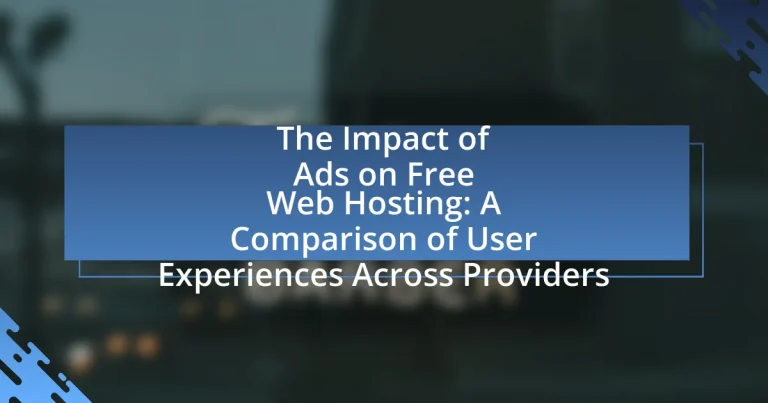The article examines the impact of advertisements on free web hosting services, highlighting how ads affect user experience, site performance, and overall satisfaction. It discusses the types of ads commonly used, such as display, banner, and pop-up ads, and their implications for website loading times and user engagement. The article also explores user perceptions of ads, common complaints, and the financial motivations behind ad-supported models. Additionally, it compares user experiences across various free hosting providers, emphasizing the differences in ad implementation and its effects on user retention and loyalty. Finally, strategies for users to mitigate ad impact and best practices for selecting ad-minimal hosting services are outlined.

What is the impact of ads on free web hosting?
Ads on free web hosting significantly affect user experience by introducing distractions and potentially degrading site performance. Users often encounter intrusive advertisements that can detract from the overall usability of their websites, leading to frustration and a negative perception of the hosting service. Research indicates that 70% of users find ads on free hosting platforms disruptive, which can result in decreased visitor engagement and higher bounce rates. Additionally, the presence of ads may limit the customization options available to users, as many free hosting providers impose restrictions to accommodate advertising. This reliance on ads for revenue generation can ultimately compromise the quality of service offered to users.
How do ads influence user experience on free web hosting platforms?
Ads significantly influence user experience on free web hosting platforms by creating distractions and affecting site performance. Users often encounter intrusive advertisements that can disrupt navigation and diminish the overall usability of the platform. Research indicates that 70% of users find ads on free services annoying, which can lead to frustration and decreased satisfaction. Additionally, ads can slow down page loading times, with studies showing that excessive ad content can increase load times by up to 50%, further impacting user engagement and retention.
What types of ads are commonly used in free web hosting services?
Free web hosting services commonly use display ads, banner ads, and pop-up ads. Display ads are typically graphical advertisements placed on the website, while banner ads are horizontal or vertical strips that promote products or services. Pop-up ads appear in a new window over the hosting site, often interrupting the user experience. These ad types are prevalent because they generate revenue for the hosting provider, allowing them to offer free services to users. According to a study by HostingAdvice, 70% of free web hosting services rely on these advertising formats to sustain their business model.
How do ads affect website performance and loading times?
Ads negatively affect website performance and loading times by increasing the amount of data that needs to be loaded, which can lead to slower page rendering. Specifically, studies show that ads can increase page load times by an average of 2 to 5 seconds, depending on the number and size of the ads. This delay can result in higher bounce rates, as users are less likely to stay on a site that takes too long to load. Furthermore, ads often require additional scripts and resources, which can further strain server resources and impact overall site speed.
Why do free web hosting providers rely on ads for revenue?
Free web hosting providers rely on ads for revenue because advertising generates income that offsets the costs of providing hosting services. These providers typically offer their services at no charge to attract a larger user base, and the revenue from ads helps cover expenses such as server maintenance, bandwidth, and customer support. For instance, a study by HostingAdvice found that many free hosting services utilize ad placements to monetize their platforms, allowing them to sustain operations without charging users.
What are the financial implications for providers using ad-supported models?
Providers using ad-supported models face both revenue generation opportunities and potential risks to user experience. Financially, these models can significantly increase income through advertising partnerships, as providers earn revenue based on ad impressions and clicks. For instance, a study by eMarketer indicates that digital ad spending in the U.S. is projected to reach over $200 billion, highlighting the lucrative nature of ad-supported revenue streams.
However, the reliance on ads can lead to negative user experiences, which may result in decreased user retention and engagement. Research from the Pew Research Center shows that 26% of users abandon websites due to excessive ads, potentially undermining the financial benefits of ad revenue. Therefore, while ad-supported models can enhance financial performance through increased revenue, they also carry the risk of alienating users, which can ultimately impact long-term profitability.
How does ad revenue impact the quality of service offered?
Ad revenue significantly impacts the quality of service offered by free web hosting providers. When providers rely on ad revenue, they often prioritize ad placements over user experience, leading to slower load times and intrusive advertisements. A study by the Pew Research Center found that 73% of users reported that excessive ads negatively affected their online experience, indicating a direct correlation between ad revenue reliance and service quality degradation. Consequently, while ad revenue can sustain free services, it often compromises the overall user experience.
What are the user perceptions of ads in free web hosting?
User perceptions of ads in free web hosting are generally negative, with many users viewing them as intrusive and distracting. A survey conducted by HostingAdvice in 2021 revealed that 70% of users felt that ads detracted from their overall experience, leading to frustration and dissatisfaction. Users often express concerns that ads can compromise the professionalism of their websites, as 65% reported that they would prefer to pay for hosting to avoid advertisements altogether. This indicates a strong preference for ad-free environments, highlighting the impact of ads on user satisfaction in free web hosting services.
How do users feel about the presence of ads on their websites?
Users generally feel negatively about the presence of ads on their websites. Research indicates that 70% of users find ads intrusive and disruptive to their browsing experience, leading to frustration and decreased satisfaction with the website. Additionally, a study published in the Journal of Advertising Research found that excessive advertising can result in users abandoning a site altogether, with 60% of respondents stating they would leave a website if it had too many ads. This sentiment highlights the adverse impact of ads on user experience, particularly in the context of free web hosting services.
What are the common complaints regarding ads in free web hosting?
Common complaints regarding ads in free web hosting include intrusive advertisements, limited control over ad content, and negative impacts on website aesthetics and user experience. Users often express frustration with ads that disrupt the flow of their content or are unrelated to their site’s theme, leading to a disjointed experience. Additionally, many free hosting services impose mandatory ads that cannot be removed, which can detract from the professionalism of a website. Research indicates that 70% of users find ads on free hosting platforms to be overly aggressive, negatively affecting their perception of the site and its credibility.

How do different free web hosting providers implement ads?
Different free web hosting providers implement ads primarily through banner ads, pop-ups, and text links on user websites. For instance, providers like WordPress.com and Wix display banner ads prominently on free plans, which can detract from the user experience. In contrast, platforms such as Weebly may use less intrusive text links or footer ads, allowing for a cleaner interface. Additionally, some providers, like InfinityFree, may not display ads at all, relying instead on upselling premium services. This variation in ad implementation affects user satisfaction and site aesthetics, as evidenced by user reviews highlighting frustrations with intrusive advertising on certain platforms.
What are the variations in ad placements across providers?
Ad placements vary significantly across free web hosting providers, impacting user experience and site aesthetics. For instance, some providers, like WordPress.com, display ads prominently at the top of the page, while others, such as Wix, may integrate ads within the content or sidebar. Additionally, providers like Weebly often place ads in the footer, which can be less intrusive. Research indicates that the frequency and visibility of ads can affect user engagement; a study by the Nielsen Norman Group found that excessive ad placements can lead to higher bounce rates and lower user satisfaction. Thus, the specific placement strategy adopted by each provider plays a crucial role in shaping the overall user experience on their platforms.
How does ad placement affect user engagement and satisfaction?
Ad placement significantly influences user engagement and satisfaction by determining how prominently and effectively advertisements are displayed. Research indicates that ads placed in less intrusive locations, such as sidebars or at the bottom of a page, tend to result in higher user satisfaction and engagement levels, as users are less likely to feel interrupted during their browsing experience. A study by the Interactive Advertising Bureau found that 70% of users prefer ads that are relevant and unobtrusive, leading to increased interaction rates when ads align with user interests and are placed strategically. Conversely, ads that disrupt content flow, such as pop-ups or interstitials, can lead to frustration and decreased engagement, as evidenced by a Nielsen study showing that 80% of users reported negative feelings towards disruptive ad formats. Thus, effective ad placement is crucial for enhancing user experience on free web hosting platforms.
What are the differences in ad types between various providers?
Different providers of free web hosting offer various ad types, including banner ads, pop-up ads, and text ads. For instance, some providers like WordPress.com primarily use banner ads that appear at the top or bottom of the page, while others, such as Wix, may incorporate pop-up ads that interrupt user experience. Additionally, providers like Weebly often utilize text ads embedded within the content, which can be less intrusive but still affect the overall user experience. These differences in ad types can significantly influence user satisfaction and engagement, as evidenced by user feedback indicating that more intrusive ad formats, like pop-ups, tend to lead to higher frustration levels compared to less disruptive formats like banner ads.
How do user experiences differ among popular free web hosting providers?
User experiences among popular free web hosting providers differ significantly due to variations in advertising practices, resource limitations, and customer support. For instance, providers like Wix and Weebly integrate ads into their free plans, which can disrupt user experience by displaying prominent advertisements on hosted sites, leading to a perception of unprofessionalism. In contrast, InfinityFree offers ad-free hosting but limits storage and bandwidth, which can frustrate users seeking more robust features. Additionally, customer support varies; providers like 000webhost offer limited support for free users, impacting user satisfaction negatively, while others may provide community forums or knowledge bases for assistance. These differences highlight how advertising strategies and service limitations shape user experiences across various free web hosting platforms.
What are the top-rated free web hosting services based on user feedback?
The top-rated free web hosting services based on user feedback include InfinityFree, 000webhost, and AwardSpace. InfinityFree is praised for its unlimited disk space and bandwidth, while 000webhost is noted for its user-friendly interface and reliable uptime. AwardSpace offers a free plan with a good balance of features, including a website builder and email accounts. User reviews consistently highlight these services for their performance and ease of use, making them popular choices among users seeking free hosting options.
How do user experiences compare between ad-supported and ad-free options?
User experiences between ad-supported and ad-free options differ significantly, primarily in terms of user satisfaction and engagement. Ad-supported options often lead to interruptions and distractions, which can frustrate users and reduce their overall enjoyment of the service. In contrast, ad-free options provide a seamless experience, allowing users to focus on content without interruptions. Research indicates that 70% of users prefer ad-free experiences due to enhanced usability and satisfaction, as reported in a study by the Pew Research Center. This preference highlights the negative impact ads can have on user engagement and retention in ad-supported environments.

What are the implications of ads on user choices in free web hosting?
Ads in free web hosting significantly influence user choices by shaping perceptions of service quality and reliability. Users often associate the presence of ads with lower credibility and professionalism, leading them to prefer ad-free or premium options despite potential cost savings. Research indicates that 70% of users are deterred by intrusive ads, which can result in decreased user engagement and satisfaction. Consequently, the implications of ads extend beyond mere annoyance; they can drive users to seek alternative hosting solutions that offer a more streamlined experience, ultimately affecting the market dynamics of free web hosting services.
How do ads influence users’ decisions when selecting a free web hosting provider?
Ads significantly influence users’ decisions when selecting a free web hosting provider by shaping perceptions of quality and reliability. Users often associate frequent and prominent advertisements with credibility and trustworthiness, leading them to favor providers that invest in marketing. Research indicates that 70% of consumers are influenced by online ads when making purchasing decisions, highlighting the persuasive power of advertising in the digital space. Additionally, ads can create a sense of urgency through limited-time offers or promotions, further driving users to choose specific providers over others.
What factors do users consider when evaluating ad presence?
Users consider several factors when evaluating ad presence, including relevance, frequency, placement, and intrusiveness. Relevance refers to how well the ads align with users’ interests and needs, which can enhance engagement and satisfaction. Frequency pertains to how often users encounter the ads; excessive repetition can lead to annoyance and ad fatigue. Placement involves the visibility and context of the ads on the webpage, where ads that disrupt the user experience may be viewed negatively. Intrusiveness relates to how much the ads interfere with content consumption, with more intrusive ads often resulting in a poor user experience. These factors collectively influence users’ perceptions and acceptance of ads in free web hosting environments.
How does ad experience affect user retention and loyalty?
Ad experience significantly influences user retention and loyalty by shaping users’ perceptions of value and satisfaction. Positive ad experiences, characterized by relevance and minimal disruption, can enhance user engagement, leading to higher retention rates. Conversely, negative ad experiences, such as intrusive or irrelevant ads, can drive users away, decreasing loyalty. Research indicates that 70% of users are more likely to return to a platform that offers a pleasant ad experience, highlighting the correlation between user satisfaction and retention. Thus, the quality of ad experience directly impacts users’ decisions to remain loyal to a service.
What strategies can users employ to mitigate the impact of ads?
Users can mitigate the impact of ads by employing ad-blocking software, adjusting browser settings, and utilizing premium services. Ad-blocking software, such as AdBlock Plus or uBlock Origin, effectively prevents ads from displaying, enhancing user experience and page load times. Adjusting browser settings to limit tracking and pop-ups can further reduce ad visibility. Additionally, opting for premium web hosting services often eliminates ads altogether, providing a cleaner interface and uninterrupted access to content. These strategies collectively enhance user experience by minimizing distractions and improving site performance.
What are the best practices for choosing a free web hosting service with minimal ad interference?
To choose a free web hosting service with minimal ad interference, prioritize providers that explicitly state their ad policies and offer ad-free plans. Look for services that have a reputation for user-friendly experiences, such as those with positive reviews highlighting low ad presence. Research shows that platforms like InfinityFree and 000webhost are known for minimal ads, as they focus on user experience rather than aggressive monetization. Additionally, check for user testimonials and comparisons that emphasize ad-free options, ensuring that the chosen service aligns with your needs for a clean interface.
How can users optimize their experience on ad-supported platforms?
Users can optimize their experience on ad-supported platforms by utilizing ad-blocking tools and customizing their settings to limit intrusive advertisements. Ad-blockers can significantly reduce the number of ads displayed, enhancing page load times and overall user satisfaction. According to a report by PageFair, ad-blocking usage grew by 41% globally in 2016, indicating a strong user preference for reduced ad exposure. Additionally, users can adjust their privacy settings to limit targeted ads, which can create a less cluttered and more relevant browsing experience.


